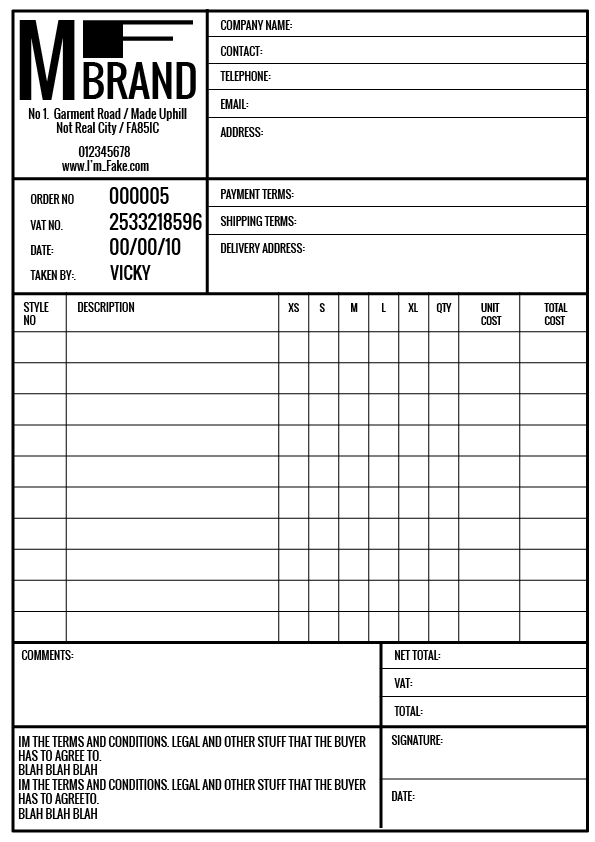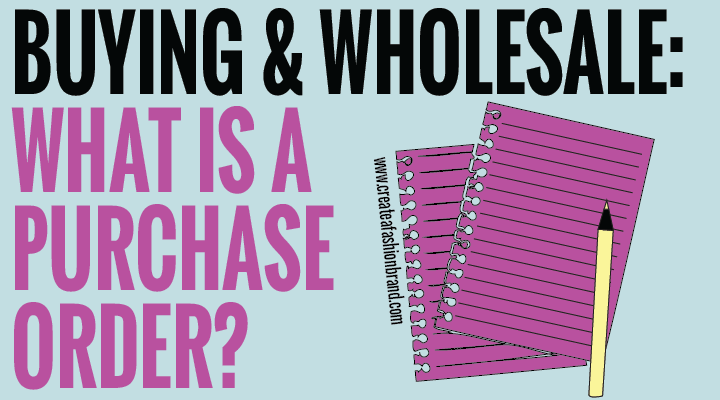If you are thinking about creating a fashion brand or a single product, then at some point you will have to make your products in bulk and sell them. Hopefully you will be selling through your own shop or website, but for more sales, you will want to think about wholesale.
This can seem a little daunting, mainly because of the many laws and regulations involved with shipping and imports.
Don’t panic. In this post I’m going to cover one of the documents you will need to be able to purchase products from a factory, create your own or sell to buyers. A Purchase Order or PO.
By the time you’ve finished the post, you’ll know what it is for. What it should contain and how to avoid getting caught up in all of the red tape.
SO FIRST…..BUYER OR SELLER?
When you’ve got your fantastic products through the sampling process and you are happy with them, you finally need get them produced in bulk. You may then even decide to sell them onto a buyer.
In the first stage of getting your clothes manufactured, you are a buyer. You are essentially buying your products from the factory that will make them.
In the same way, if you are buying in ready made products, you again are a buyer of these items.
If you then decide that you want to get your products into a department store, or supply a brand with products, you then become a seller. The representative of the store or brand is the buyer.
It all seems very simple right? It is.
The reason I mention it is that many people forget that they too are buyers at one stage of the process and think only about selling their products to others.
WHAT IS A PURCHASE ORDER?
So next. What is a Purchase Order?
Well, now the first part will become a little clearer.
A Purchase Order is a legal contract between a Buyer and a Seller. It is a document that shows a promise or intent from the buyer to purchase what is written on the document, from the seller.
There are of course a number of details on a PO that will cover how, what, where and when. We’ll get onto these in a minute, but it’s important to recognise that whether you are the buyer or seller in the situation, this is a legally binding contract and should be read carefully and taken seriously.
TEMPLATES
There is no standard template or rigid structure for how a purchase order is laid out. The content and what it covers is far more important and you should be aware of them so that you as the buyer or seller, are protected at all times legally. The main picture above is just one that I have mocked up for the post and some seminars, but they can come in many different formats and will not necessarily look like the image.
IMPORTANT PARTS OF A PURCHASE ORDER
There are number of elements that you need to focus on when filling in a purchase order or creating one. Many of these terms you will have to know more about and will have to discuss with your factory, supplier or buyer, depending on what situation you are in.

BUYER LOGO AND CONTACT DETAILS
A logo for your company is not actually necessary, but since most companies like to put their branding on their stationary, it makes sense to put it with your company details.
Whether you choose to add your logo or not, it’s important to remember to make sure all details are as registered legally. As a company, individual and so on.
Your details should include:
- Company Name
- Company Address
- Company Telephone Number
- Company Email
- Plus any other method of contacting you.
ORDER NUMBER
An order number makes this particular purchase order unique to all others. It gives it a unique identifying code. Not just for you but for your suppliers also.
You must make sure that the same number is not used on more than 1 order and you keep a record of all of the numbers as well as what it was for, dates created and signed and when the order was completed.
VAT NUMBER
This doesn’t apply to everyone, but if you are VAT registered, you should add this also. Depending on your laws, you or your supplier. may be entitled to claim back VAT.
DATE
This specific date is the one when the purchase order was created. It will be different to the signature date, so it’s important to have this on your document in case it needs to be checked later on. It is also the date used in your record keeping and accounts as the first date of the order.
TAKEN BY
If you have more than yourself working on sales or sourcing, you may need to identify a staff member. Having their name on the order allows you to keep your records up to date and clear, should you, or someone else need to go back to them.
SUPPLIER DETAILS
In the same way you should put all of your details on the form, you will also need the details of the supplier.
Again this covers the list as before, however I’ve added a ‘Contact’ box in the list which is the person you have been dealing with at your suppliers. For the same reason, it is best to keep your records clear.
The supplier details should include:
- Supplier name
- Supplier Contact Name
- Supplier Email
- Supplier Telephone Number
- Supplier Address
PAYMENT TERMS
Your payment terms are ones that you have agreed on with your supplier or factory. They should cover a number of things like:
- How the money will be paid
- When payment is expected or the Conditions where payment will be completed.
- From what into what? Cheque / Bank Transfer / Cash etc…
SHIPPING TERMS:
Shipping in this case does not mean ‘On a ship’. ‘Shipping’ in this case means how the products will get from the supplier to the buyer.
The terms you decide for shipping are much like the payment section:
- When the goods will be delivered, including a delivery date.
- How they will delivered to you.
- From where? What city / Port / Airport etc…
- Insurance coverage for your products during delivery.
- And handover terms.
At some point during shipping, the responsibility for the products as well as insurance will be handed over from the seller to the buyer. This point has to be agreed by both parties and noted on the purchase order. They are usually referred to using acronyms like Freight [ or Free ] On Board or FOB.
You can find more of these acronyms in one of our other blog posts, TERMINOLOGY: THE MAIN 6 DELIVERY TERMS [ TERMS OF SALE ] EXPLAINED
DELIVERY ADDRESS:
As well as your terms, make sure that you have the factory’s address. It’s important to have both the company address and the address where the goods will be coming from in case they are different or there is a problem and you have to track them down.
PRODUCT DESCRIPTION
You must make sure that what you are ordering is very, very clear. You should include a number of details such as:
- Style number
- Description
- Colour, fabric, print options per style
- Each Size
- Quantity of units [or products] per size
- Total number of units per style
- The unit price [ price per product ]
- Total price for the units ordered
BIT MORE MONEY STUFF
At the bottom you want to make sure that all of the numbers are correct and so that there is no confusion, add up the total price you are paying the seller or factory.
You may also want to add on VAT, if it’s appropriate and then do a final total underneath.
Of course if you have other costs, sales laws or financial regulations that need to be added here, then please add them in also, but usually it is the total and occasionally VAT.
LAST LEGAL AND COMMENTS SECTION
The last two sections I’ve labelled ‘Comments’ and ‘Other Legal Terms or Conditions’. Really these boxes are for any other specifics you want to add. You can leave them out of course, but the more specific you are, the more air tight the contract is.
So what else?
Well, different brands and companies specify many different things. The ones I would suggest are:
PACKAGING
- Packaging details.
- How it will be packaged? In groups of 10? Individually?
- With what? In plastic bags? Tissue paper? Foam chips?
- Hangers or no hangers?
- How will the boxes or outer wrapping be labelled?
LABELLING REQUIREMENTS
- Artwork references for labels.
- What labels should be inside the garments?
- What should be on the packaging?
- Any specific labels? Fabric composition? Country of Origin? Care Wash? Garment code?
COST INCLUDES
Now usually there is some type of indication to the buyer, what the cost is being paid for through other descriptions and terms. But some brands like to be very specific on their POs.
The last section, which it doesn’t hurt to repeat, is exactly what jobs the payment is for. So for example, you could put something like “Cost Price Includes” and then list the specific jobs that are being done for that price, for example:
Labelling and Packaging as stated
Commission or Seller’s Mark up
Delivery to ‘X’ …. etc
SIGNING OFF
In buying, it is customary to ‘sign off’ or confirm that each sample of your product that you receive is correct. I would always suggest that you make sure you include a statement on your PO that tells the supplier that you will only pay for the order if it what you have in fact confirmed.
That way, if the factory tries to send you something else, or makes a mistake [and it can happen] you are not liable for their mistake in terms of cost.
So as my last tip, I would always advise that you add something along the lines of
“Order and payment is subject to the approval of final product samples”
Which basically means that the order and purchase order [your contract] are only in place if the goods are delivered as you requested and signed off.
FINALLY….
In this post we’ve covered all of the content you will need for a legally binding purchase order. Hopefully you are now prepared to create a Purchase Order or sign one of your own.
Remember that this is a contract, regardless of what it’s called and you should never sign one if you are unsure of what it says or contains. In the same way, you must cover own fashionable bottom and make sure that if you create one, you include all of the items you need to make the order clear and airtight.
[wc_fa icon=”cogs” margin_left=”” margin_right=””] Action Steps:
Now I want you to take action with a little task. I want you to create a template with these things included. It doesn’t need to be fancy, just clear.
If you have a factory already, ask them some of the questions you need to fill in the PO and get it ready for your order.
If not, make a list of the questions you will need to ask a factory once you are using one.
P.S.
If you want more information on building your fashion brand or if you know anyone that this information might help, including some more tips on manufacturing and products, then join our weekly Brand Building Email Family by clicking the image below.

